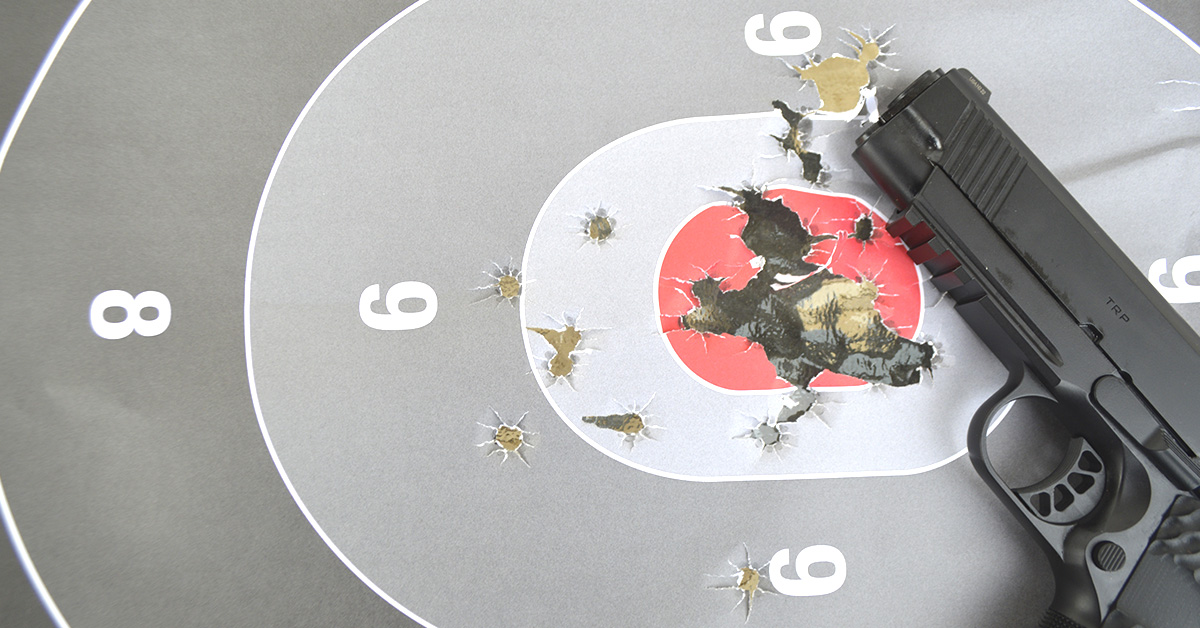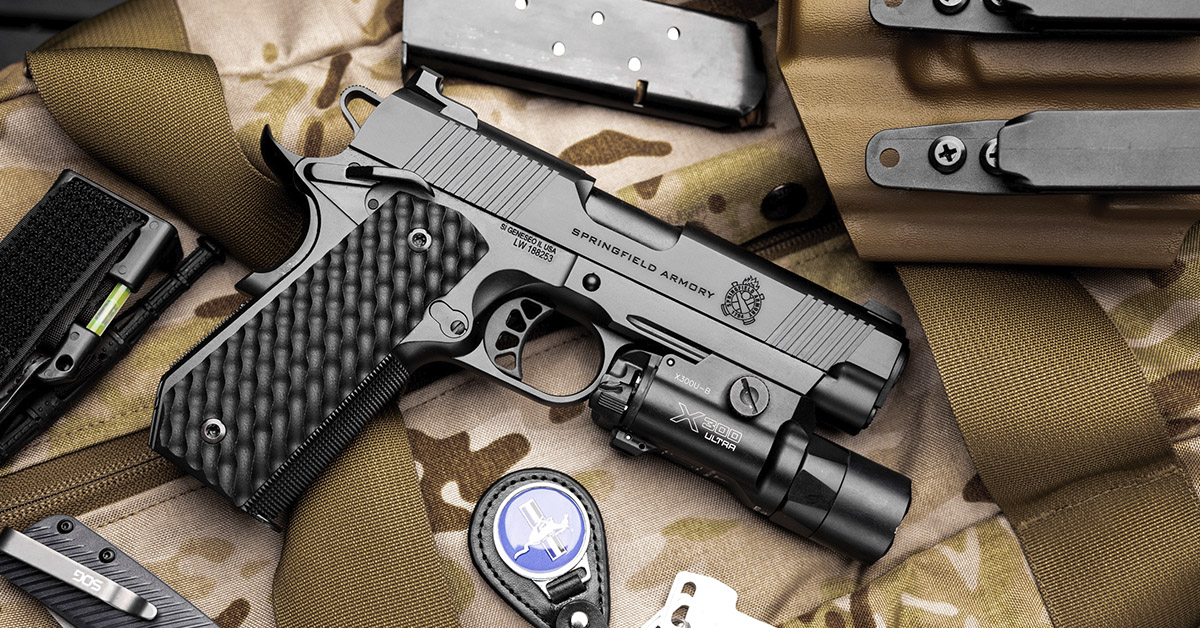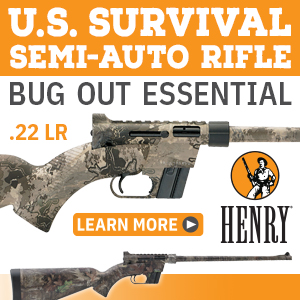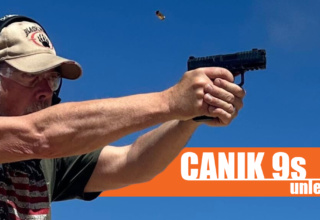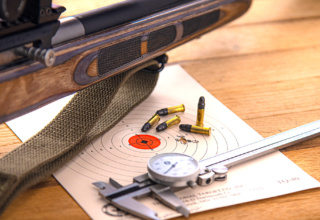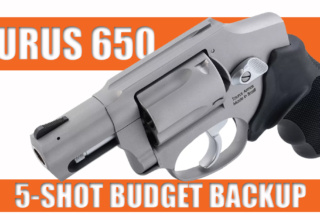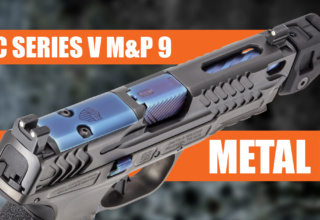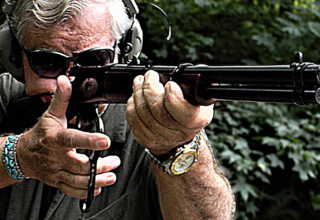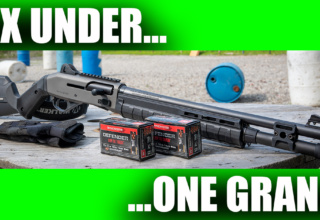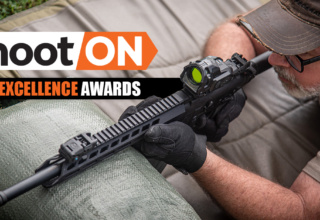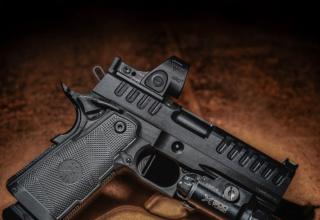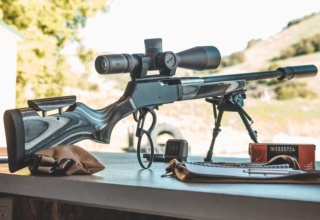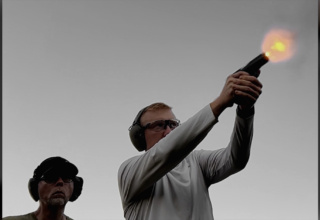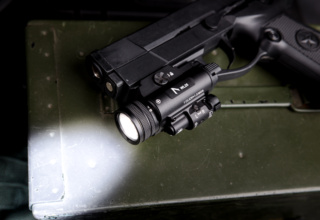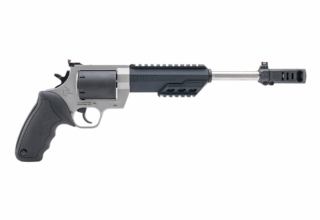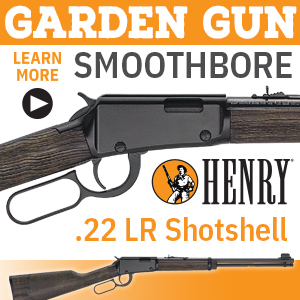A premium performer that punches hard, punches accurately, and brings that punch in an easy to carry, easily concealed package, the TRP CC (Carry Contour) .45 ACP is the ticket for those who fancy a “subtle sledgehammer”
by Bob Campbell
Some years ago, I watched with great interest as the FBI ran a test program to choose the new FBI SWAT pistol. The test was grueling — much more intensive than the original test that qualified the 1911 pistol for armed services issue.
The original 1911 test program ran to 6,000 rounds. The Colt was fired until hot and dunked in a water bucket. Accuracy requirements included firing from a solid rest (there were machine fixture tests a few years later) with what were for the day demanding accuracy standards. The 1911 was required to place five bullets into a five-inch group at 25 yards and a ten-inch group at 50 yards. Most 1911 pistols were more accurate. The 1920s 1911A1 was even more accurate.
In modern SWAT qualified tests, the FBI demanded 25,000 rounds between stoppages. The accuracy standard with Remington 230-grain Golden Saber ammunition was a 1.25-inch group at 25 yards. The original Springfield Bureau Model met or exceeded the standards set (for public sales now called the Professional). Springfield Armory offered the Professional to civilian sales and a very interesting and more affordable version, the Tactical Response Pistol, as well.
It took some time to be able to afford a TRP. I have owned several and consider the TRP my go-to 1911 in the event of alarms and emergencies or a call to competition. The TRP isn’t for everyone. My son, Major Matthew Campbell, had a TRP for some time on my recommendation. He later sent a stainless Springfield 1911 to Novak’s Gun Shop, and this is his go-to pistol. He did not like the raspy front strap checkering and weight of the TRP. His 1911 is basically a GI lower with a very good trigger, Novak sights, and a tuned extractor. So, the TRP may be an acquired taste. Let’s look at the newest TRP, the TRP CC (Carry Contour).
A Note on Quality
Springfield may offer a pistol at least comparable to a high-end 1911 at a very fair price based on production capability and experience. There are plenty of arguments either way, but that is my opinion, and I have owned or still own those examples of the gun maker’s art. For most of us, a pistol retailing at $1799 or more requires plenty of justification and it better be an exceptional 1911! The TRP 4.25 CC is such a pistol.
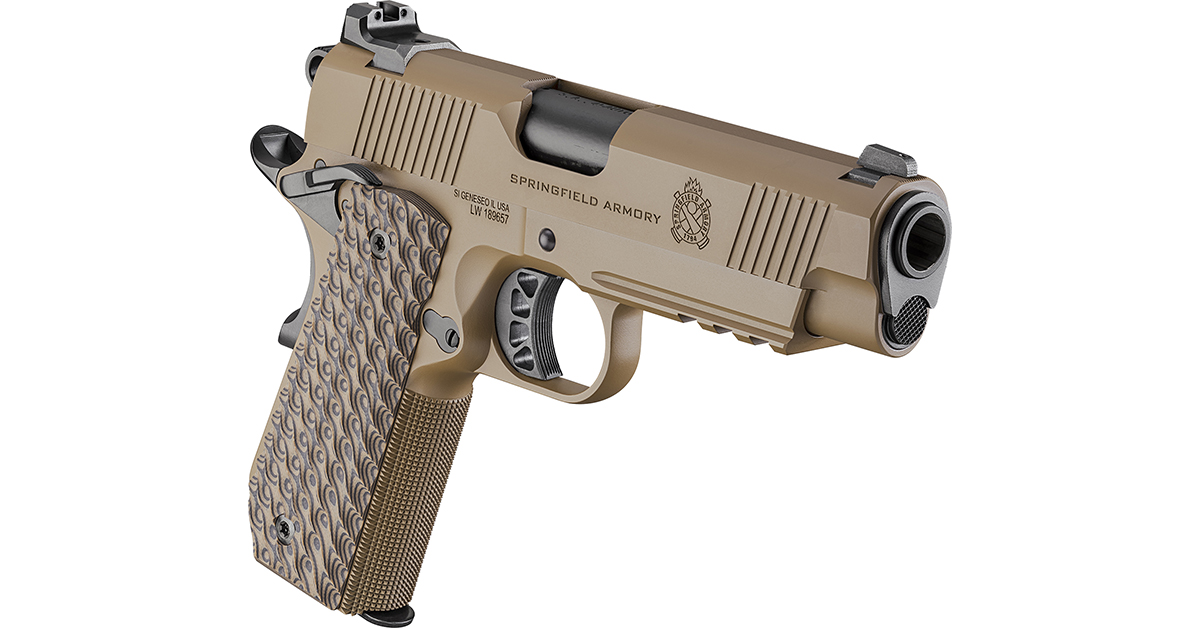
The TRP offers excellent features — I cannot think of anything I would add — and it is a great shooting handgun in every sense of the word.
I have spent tons of money and expended considerable time and effort and have not ended up with a 1911 as reliable as this one. There are things that just cannot be done. You cannot take a Springfield Loaded and make it a TRP, try as you might. The TRP is tighter and built to different tolerances. You would have to purchase an oversize custom barrel and fit it expertly, then tighten the frame-to-slide fit in a laborious process, and then lap the slideways to a workable fit and function. I have done it, but then nothing was available from the factory like the TRP. My opinion may be subjective, relative, or even arbitrary, but it really isn’t an opinion from my line of sight but a conclusion.
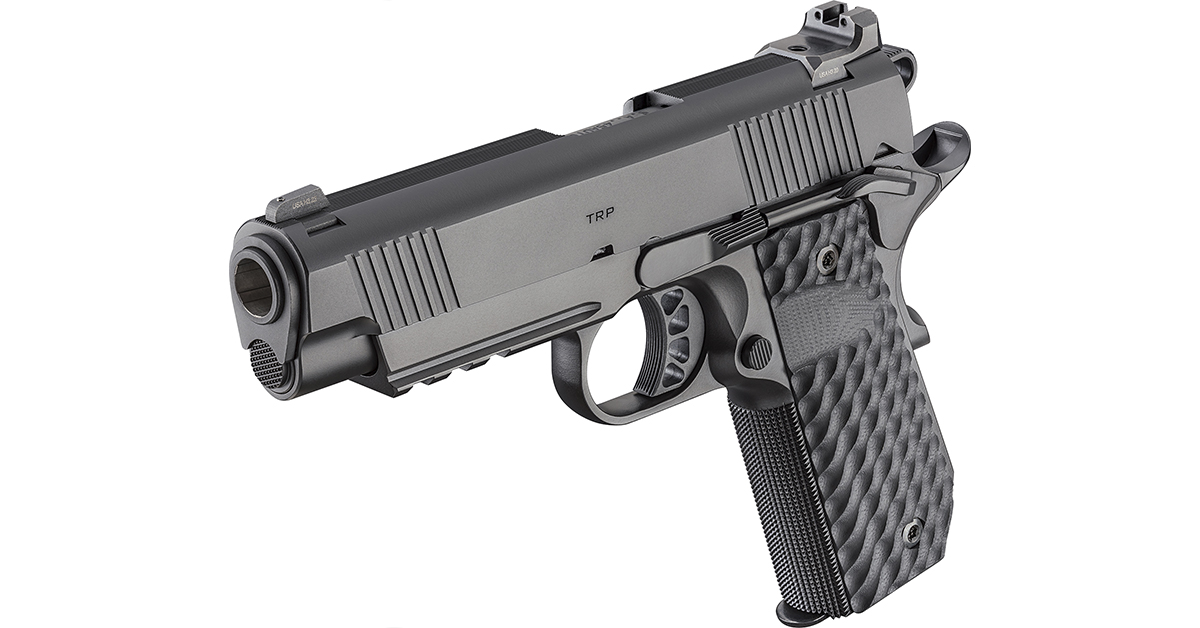
My personal TRP CC is the black finish railed version. The Carry Contour model features a light rail for mounting a combat light and extremely aggressive checkering for a factory pistol. It isn’t for everyone. My friend Roger likened it to a cheese grater. It comes with a contour cut, as it is termed by Springfield (a bobtail cut by others), a memory groove beavertail safety, lightweight hammer, an ambidextrous slide lock safety, forward and rear cocking serrations, wedge-type rear sights and dovetailed post front sight with tritium three dot inserts in the sights, plus a hard-fitted ramped barrel.
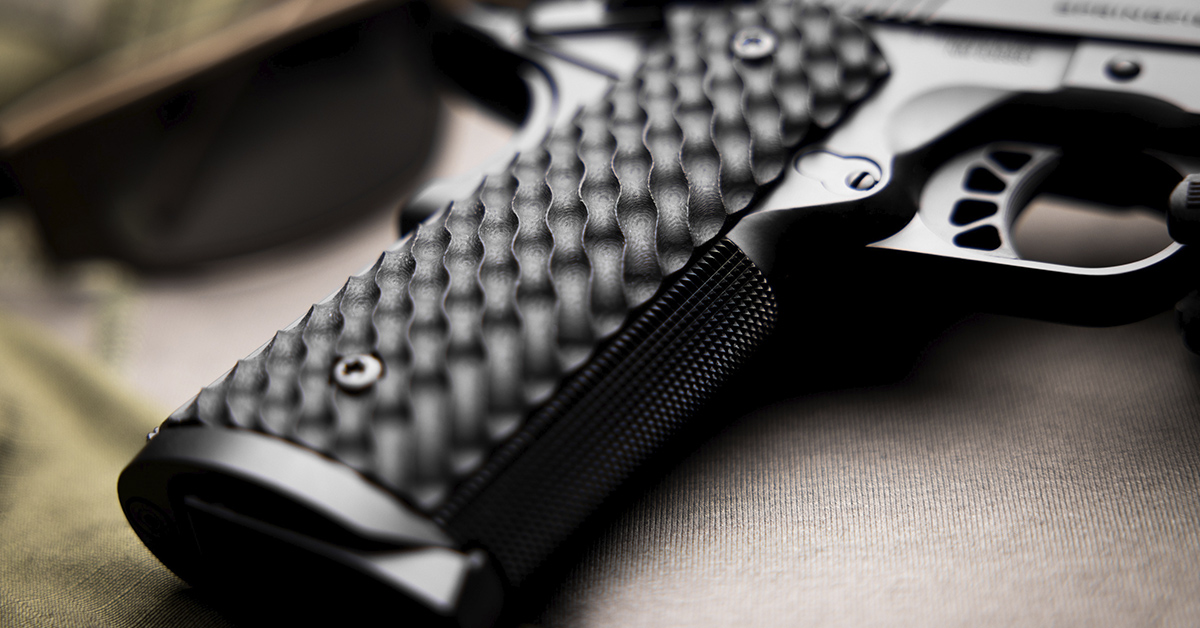
VZ Grips supply the Hydra grips. The pattern is heavy on abrasion and features a cut-out for rapid manipulation of the magazine release.
The new CC is a Commander-length pistol. This means a 4.25-inch barrel and a lightweight aluminum frame.
Many years ago, Colonel Jeff Cooper remarked that ¾-inch off the slide and barrel are pointless without the aluminum frame. I like steel frame Commander .45s but, as always, the Colonel had a point. The LW frame makes packing the pistol comfortable given a proper holster. A Government Model .45 weighs north of forty ounces loaded. That is a lot of weight on the hip — enough to bruise and abrade in some situations. I have simply struggled through carrying the weight and chose the dead nuts best carry holster and belt possible. An aluminum frame makes things easier, and the Carry Contour magazine housing makes the pistol less likely to protrude under light clothing.
This is a nice package and well thought out.
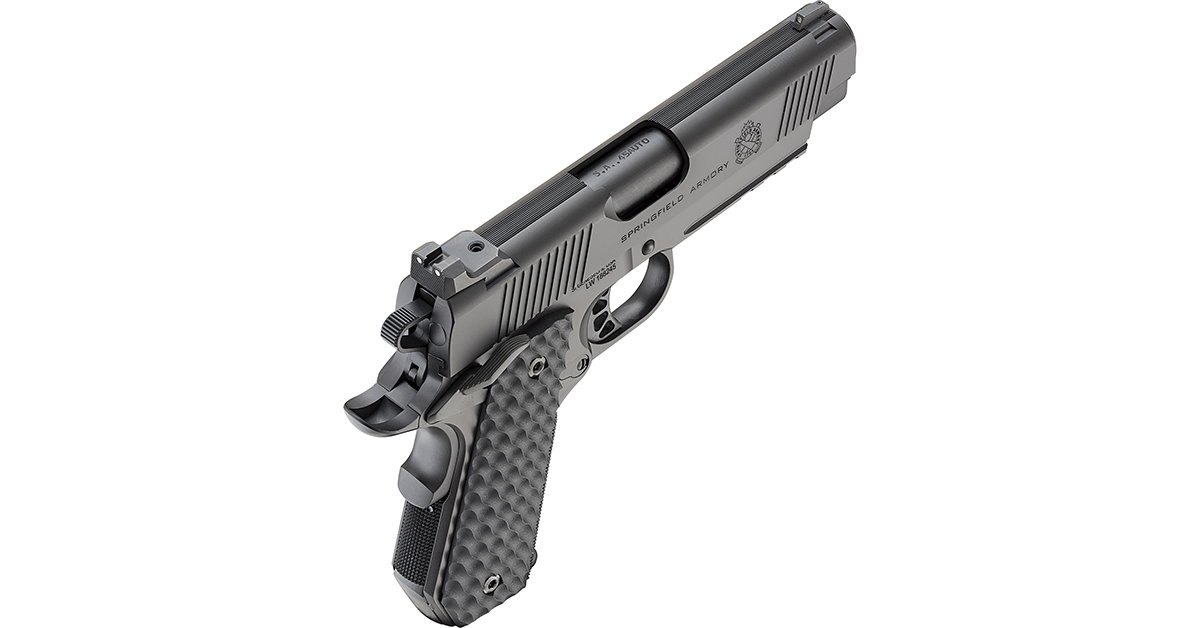
A 4.25-inch barrel as opposed to the 5-inch barrel Government length 1911 makes inside-the-waistband carry easier, especially with the Carry Contour mainspring housing. The lightweight aluminum frame shaves about ten ounces off a Government Model. The pistol is light, but when it shoots, it shoots like a big gun. The primary difference is recoil. You may run through several magazines with the TRP CC before light-weight-induced recoil becomes uncomfortable — not something you are likely to notice in a gunfight! Of course, we practice more than we fight and the TRP CC is a harder kicker than the steel frame TRP. Fortunately, the 1911’s low bore axis and a heavier recoil spring make the pistol more comfortable than expected.
Rapid fire is good but splits between shots to accurate hits will be larger. There are no free commodities and the TRP CC behaves better than most any Commander .45 I have handled. Firing the pistol and getting into the zone delivered good performance. I felt confident with this pistol from the first shot, as if I could not make a mistake. I could if I lost concentration, but my results were good. Defense shooting isn’t convenient; we don’t know when it will come, and you must practice being ready. The Springfield TRP CC will give a trained shooter an edge.
The trigger action is typical single-action, straight-to-the-rear compression 1911. There is modest take-up, barely discernable, and then the actual trigger press begins. The trigger breaks clean and crisp at 5.2 pounds. Reset is fast…very fast. A sharp reset is as important as a clean trigger press in rapid fire. In true “your grave or my grave” shooting, this trigger is an excellent feature.
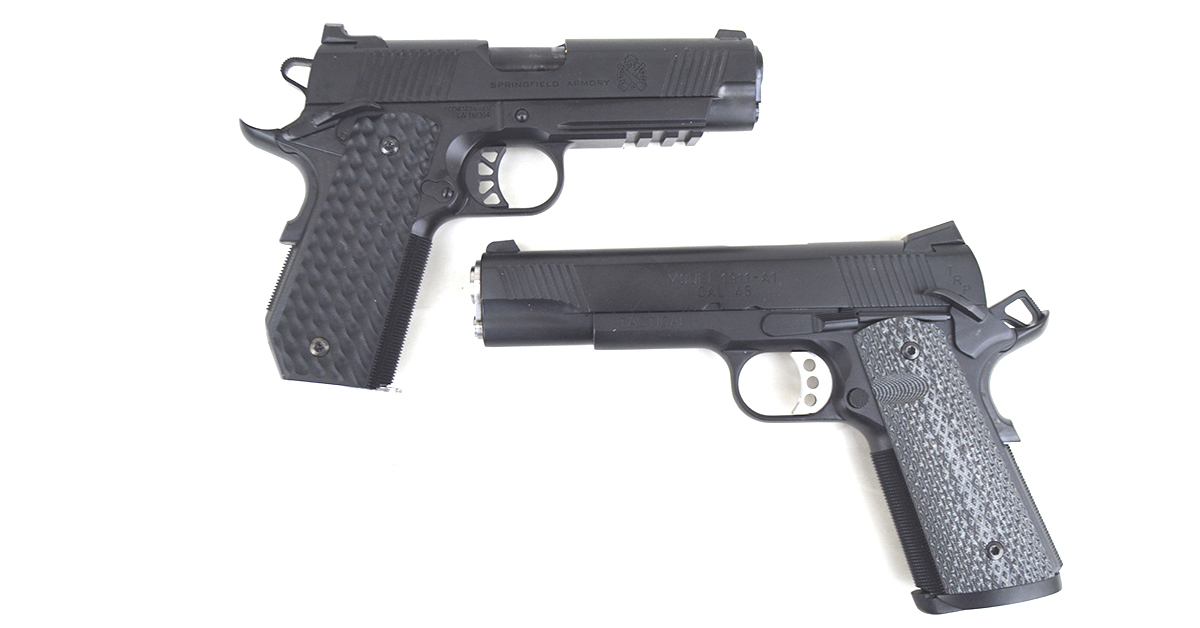
I checked barrel fit closely and when Springfield says “match grade,” this is an accurate statement. The locking lugs slide nicely into their slots in the frame. The link is well-fitted. This is a ramped barrel, providing good feed reliability and case head support. The sights are a wedge-type with three dot tritium inserts. Self-luminous iron sights are an advantage I like in a carry gun. The Springfield Tactical Rack sights allow pulling the slide by butting the rear sight into a heavy belt or boot heel with one hand if needed.
Twenty line-per-inch checkering graces the front strap. The mainspring housing is also checkered. Your hand is firmly stabilized in a hard grip when firing. The checkering isn’t that abrasive; it never drew blood from my palm or that of my cohorts. TRP checkering and its effect on clothing was one reason my son went with a Springfield GI and Novak’s Gun Shop over the TRP. (Today we would buy a Loaded Model or a Garrison 1911.) This version, with its CC butt, is less likely to abrade covering garments. Some of the toughest folks don’t like sharp checkering. So be it. I like the checkering a great deal.
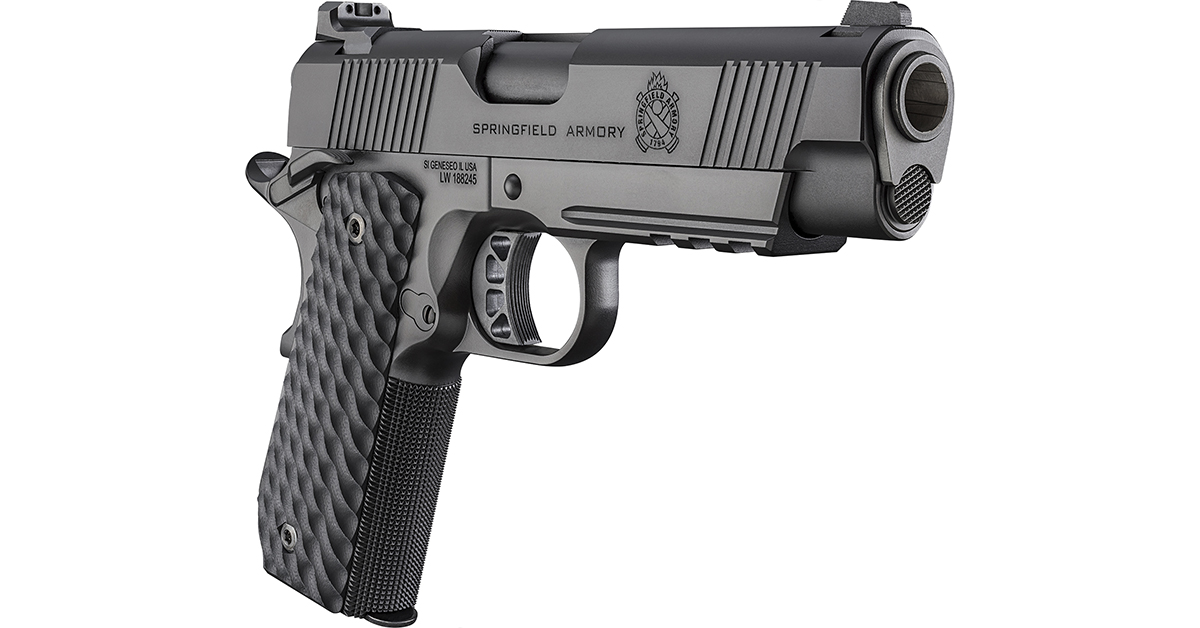
Firing the pistol was the next step after a considerable time spent in evaluation and disassembly. The TRP CC was lubricated along the slideways, slide rails, barrel hood, and cocking block as well as the barrel bushing. I elected to fire the pistol on a combat course with full metal jacketed (ball) ammunition to get a feel for the pistol’s performance. There is nothing wrong with 230-grain FMJ ammunition for combat work — .45 ACP hardball is a formidable loading. This ammunition type is also useful for defense against animals up to the small bear class and weight. Notably, Fiocchi ammunition is often match grade accurate although affordable. A good bit of Fiocchi Shooting Dynamics ammunition went down range.
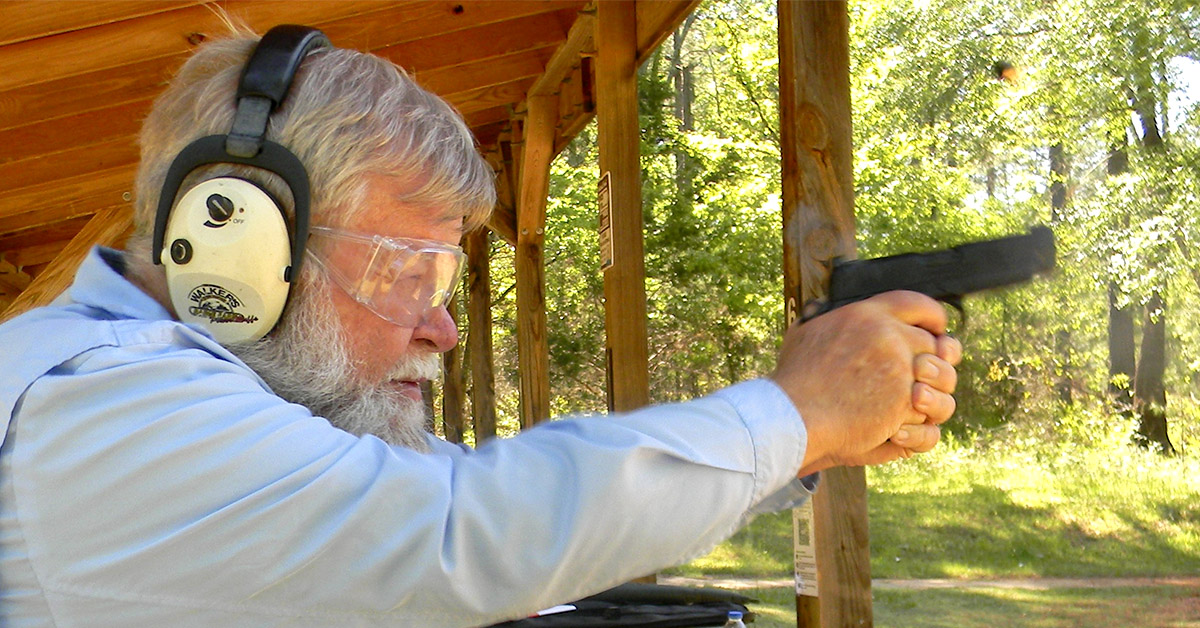
I began firing at five yards, drawing and getting on target quickly. As expected, this thoroughbred 1911 proved fast and accurate to a first-shot hit. I fired double taps, hammers, and controlled pairs, always with good results. I moved to seven yards next. The primary ammunition used in this workout was the Fiocchi Shooting Dynamics load with a few Fiocchi 230-grain jacketed hollow point Defense Dynamics worked in. Firing results were not measurably different than at five yards.
Recoil is a factor. I had on hand a steel-frame Springfield Garrison for comparison. While the TRP CC is a more advanced pistol, delivering good accuracy, the Garrison is noticeably easier on the wrists. In firing the first fifty rounds rapid fire at 5-7 yards, concentration is needed to control the pistol, but it wasn’t uncomfortable to fire.
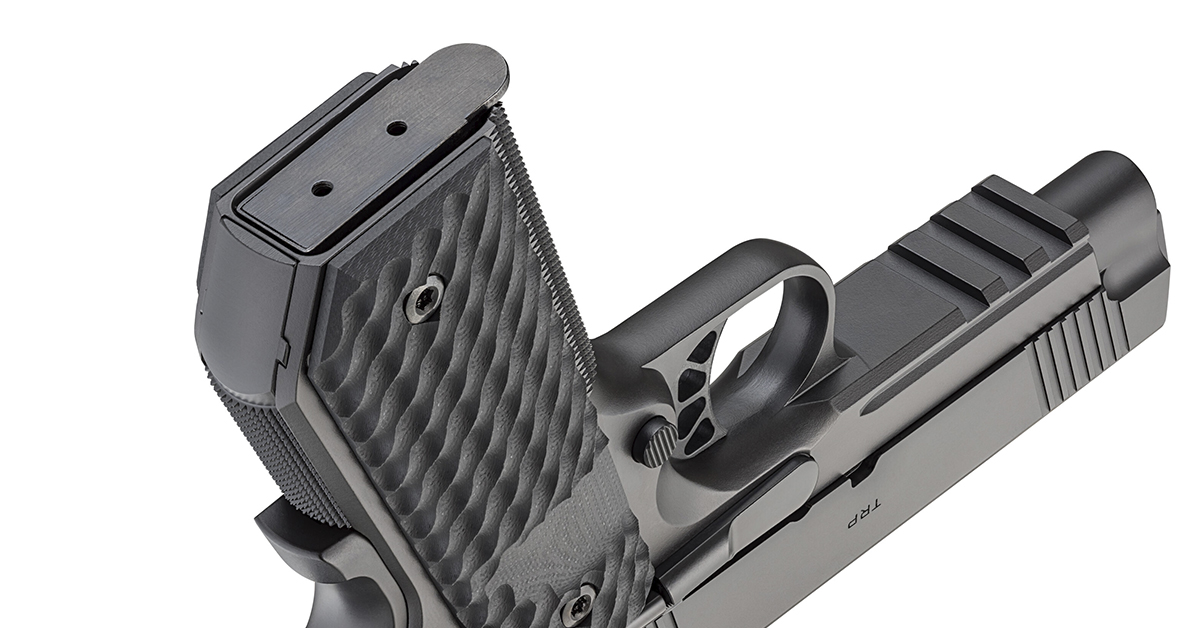
I loaded a couple more Wilson Combat magazines and then moved to ten yards. The second box of 230-grain ball ammunition was exhausted. Results were good. I slowed slightly. Speed to a first shot hit was the same but follow up shots demanded I control the sight picture more at ten yards. I also fired at 15 yards and centered the hits well. After one hundred rounds of 230-grain hardball ammunition, the Springfield TRP CC proved reliable and fast on target. I was impressed with the accuracy potential and control of this formidable pistol.
Absolute Accuracy
While 230-grain hardball has a good reputation for wound potential, it is best to take advantage of modern expanding bullet ammunition. Public safety is served by limiting both penetration and ricochet. The true answer to over penetration is to hit your target. The bullet will stay in the target in most instances with expanding bullets. Often, the handgun is angled slightly downward, and this means the bullet will find its way to earth within a few yards if it does exit.
I chose three types of expanding bullet ammunition for testing. These loads have proven accurate in other good pistols, and they did well in the TRP. Accuracy potential is good, and function is ideal. Bullet design means much in reliability and the TRP’s ramped barrel is also important.
I settled into an MTM Case-Gard K-Zone shooting rest and fired five shots of each load at 15 yards as a test of accuracy potential. I was not disappointed. The TRP put five shots of the 230-grain FMJ into 1.2 inches, the 230-grain JHP into 1.5 inches, and the fast-stepping 200-grain XTP load into an exceptional .9 inches. I really put a death grip on the pistol while firing the 200-grain XTP load.
Carrying the Springfield TRP CC
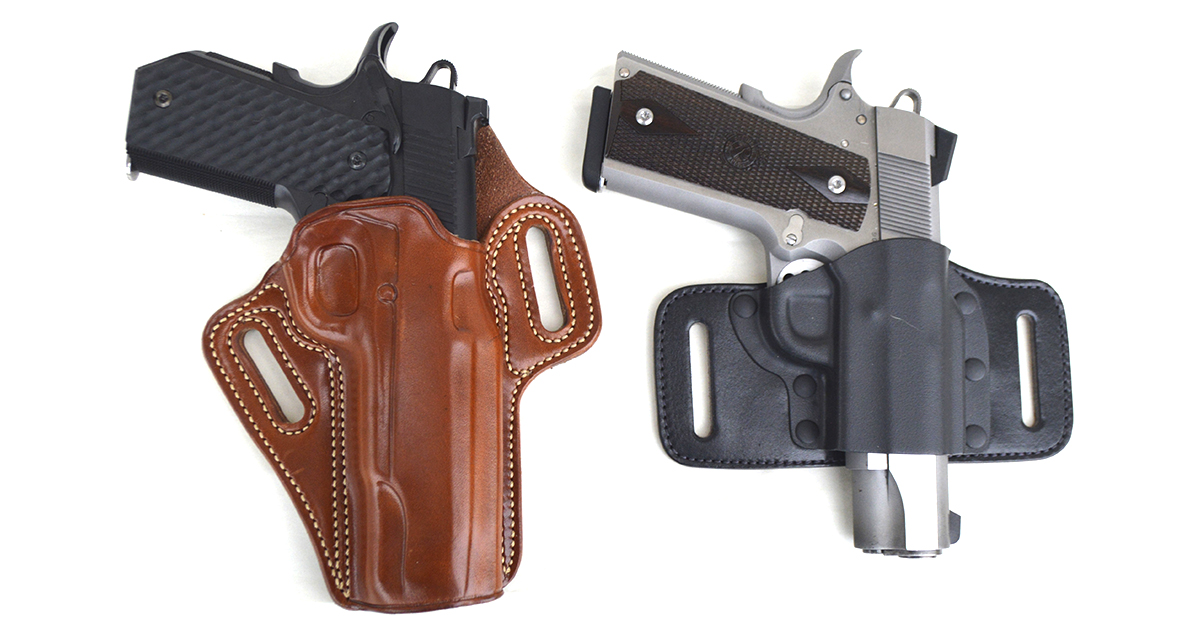
For range work, initial firing was undertaken drawing from a Galco TacSlide. This holster has a great deal of utility and is useful for practice with all 1911 frame sizes and slide lengths. The draw is sharp, and the belt slide is useful for concealed carry in some situations. For concealed carry under a light covering garment, the Galco Royal Guard IWB holster was chosen. This is a first-class holster with dual belt loops to anchor the holster to the belt. A good marriage between the holster and a proper gun belt keeps the gun and holster properly anchored. A reinforced holstering welt allows re-holstering the handgun easily. When a draping covering garment may be worn, the Galco Concealable or Concealable 2.0 are good choices. These holsters offer a sharp draw. The belt loops cinch the holster tightly toward the body, resulting in good concealment.
I like the Springfield TRP CC a great deal. Reliability is good as it should be. Combat accuracy in quickly drawing, firing, and getting follow up shots is excellent. I cannot recall an aluminum frame 1911 as well balanced as this pistol. Accuracy cannot be faulted. The Springfield TRP CC delivers performance I would expect to pay more for from a custom maker and yet the TRP CC is readily available.
What I Like
- There really isn’t anything not to like in the context of a lightweight 1911. Sure, it recoils more than a steel frame gun, but I like the fact that it carries light on the hip yet comes up firing accurately.
What I Don’t Like
- The 20 LPI checkering is sharp, but it didn’t draw blood. For what it is for, it is good. But perhaps it could be a bit less abrasive.
What I Would Change
- I am probably in the minority, but I would like a version without the light rail. Now that light-rail-compatible holsters are so plentiful, this is nitpicking.
Compare To
- Compared to top end pistols from Les Baer, Guncrafter, and Wilson Combat, the pistol gives up little or nothing. Compared to the lower strata of quality 1911 handguns — a thousand dollars or so retail — the TRP CC is a superior choice. Compared to the full-size, five-inch barrel TRP, the TRP CC is lighter and easier to carry but not as easily controlled and not quite as accurate — exactly as predicted.
Springfield Armory TRP CC Specifications
- Model: 1911 TRP CC
- Caliber: 45 ACP
- Barrel Length: 4.25 in.
- Overall Length: 7.90 in.
- Capacity: 7+1
- Frame Finish: black Cerakote
- Frame Material: aluminum
- Slide Finish: black Cerakote
- Barrel Material: stainless steel
- Twist: 1:16
- Grips: VZ Hydra G10
- Front Sight: tritium
- Rear Sight: Tactical Rack U-notch
- Height: 5.50 in.
- Includes: 3 magazines / case
- Safety: ambidextrous
- Barrel Description: match grade
- Trigger: skeletonized
- Weight: 27.30 oz.
- Hammer Type: skeletonized
- MSRP: $1999.00

